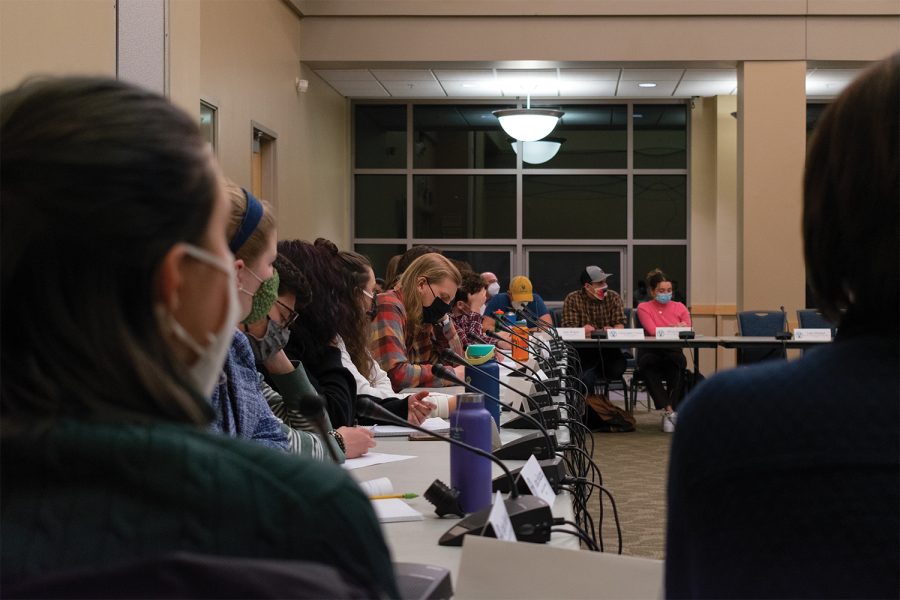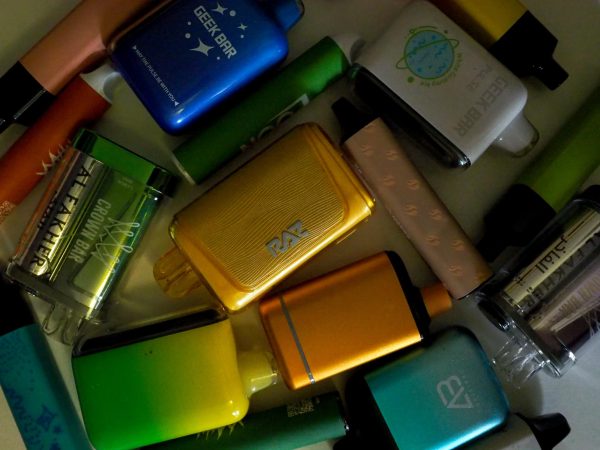SGA lacks diversity, looks to find solutions
Members of SGA take notes during a public forum in the Livak Ballroom Feb. 22.
SGA faces a significant lack of diversity due to UVM’s campus climate and additional entry barriers for students of color, said Lina Balcom, interim director of Student Life.
Students of color are unlikely to run for SGA because of the lack of diverse individuals represented in the Senate, which perpetuates the situation, said SGA Treasurer Zyakkiriah Rhoden, a senior who identifies as a Black woman.
“If you look just in the room of SGA, I’m one of one. I’m the only one that looks like me,” Rhoden said. “It’s a really uncomfortable environment sitting in Senate meetings sometimes, because not everyone has the same background as me.”
Students of color are more disadvantaged by SGA’s structures and processes than their white counterparts, Balcom said. UVM’s status as a predominantly white institution within a predominantly white state exacerbates this issue.
“SGA is as representative of the general population of students as it possibly can be,” Balcom said. “Our population of students is so highly dominant white that I would love to see maybe over-representation of some of the identities that are a lower percentage of our population.”
The historical mistreatment and exploitation of students of color by UVM also makes many hesitant to get involved, Rhoden said.
“UVM causes a lot of trauma for students of color, and to have to get up and fight to repair these wounds is not appealing to any person, much less a person of color,” Rhoden said.
Increasing diversity within an elections-based group such as SGA, presents a challenge because students choose the senators, Balcom said. Still, this intention is reflected in recruitment efforts in encouraging students to run for office and be informed about candidates.
In addition to barriers students of color face, SGA has barriers for students of verying socioeconomic status as well, said SGA Vice President Olivija Stephens, a junior who identifies as a white woman. SGA requires significant time, both in campaigning and in being a senator, which is restricting for students who are employed. Those of lower socioeconomic statuses are also less represented because of this.
However, diversity within SGA is not just about physical representation, Stephens said.
“There’s a fine line between making sure voices are heard and uplifting the voices that need space and tokenism,” Stephens said. “You wouldn’t want anyone to feel like they’re only there to be the sole representation of this entire group.”
Up until spring 2021, SGA required senator candidates to obtain signatures of endorsement, which served as an additional barrier, said SGA President Sam Pasqualoni, a senior who identifies as a white man.
“Last year the staff fully realized that to become Senator, you really don’t need any signatures,” Pasqualoni said. “[It] wasn’t really that productive, and was a barrier of entry for others.”
Pasqualoni ran for and won the position of SGA president as a write-in candidate and did not need to get signatures for that reason, he said.
Daphne Wells, the previous director of Student Life, recommended SGA remove this requirement particularly because of its impacts on students from students of color, Pasqualoni said.
These signatures were difficult to get for students of color because their community is smaller, Stephens said. Students of color do not often feel as comfortable as white students do with networking and amassing endorsement signatures, at such a predominantly white institution.
“Running for SGA felt like a huge barrier because I didn’t know how I was going to get those signatures initially,” Rhoden said. “I [didn’t] know 50 people on campus that would write on something testifying that I would be good for SGA or that they trust me to run.”
Balcom is in a temporary interim position and has not taken on any projects addressing the need to diversify SGA because of her limited time in the position.
The previous chair of the elections committee, who would typically execute recruitment efforts, recently stepped down, Balcom said. SGA Senator Shirin Dravid, a senior, recently filled this position, according to a Feb. 25 email from Stephens.
Much of addressing this issue is making sure those in power fight for those who aren’t, said junior Maeve Forbes, chair of SGA’s Committee on Diversity, Inclusion and Equity, who identifies as a white woman.
“That’s what [SGA] needs to change to: the white people on Senate and at UVM need to be willing to use their privilege for the greater good,” Forbes said.
One of CODIE’s goals is building greater positive relationships with marginalized communities, Forbes said.
“There’s still a lot of regrowth [and] rebuilding to do, we’re missing a lot of this base core foundation that needs to happen first,” Forbes said. “Attending meetings and events has been a really big thing because it’s really about having support there.”
CODIE focuses on providing small, everyday quality of life improvements for affinity groups, Forbes said. They also provide financial support through the Diversity Enhancement Fund, money made available for any club dealing with issues of diversity, equity and inclusion.
Increasing diversity will not happen overnight, Rhoden said.
“I don’t know the answer to what can make SGA a more inclusive space, but it takes a lot of time,” Rhoden said. “SGA being more engaged with the community, reaching out and making sure students of color feel safe and welcomed on campus would help the issue of diversity in SGA.”

(She/they) Halsey McLaen is a junior from Groton, Connecticut, majoring in environmental sciences with a minor in reporting and documentary storytelling....










